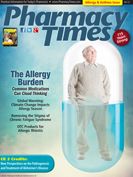Publication
Article
Pharmacy Times
Hemostasis and Thrombosis Issues
Author(s):
What Causes Blood Clots?
There are 3 broad categories (Virchow’s Triad) of factors thought to be involved in the pathogenesis of thromboses (blood clots).1 These factors were formulated by German physician Rudolf Virchow in 1856, and are basically the same factors recognized today. The triad includes the following:
1. Abnormalities in normal blood flow—eg, turbulence; venous stasis; heart disease (heart failure, atrial fibrillation, acute myocardial infarction, mitral stenosis); varicose veins; bedrest/ immobilization, pregnancy; obesity; stroke.
2. Trauma/injuries to vascular endothelium—knee/hip surgeries; heart valve disease/replacement; damage to veins arising from sheer stress or hypertension.
3. Hypercoagulability—eg, hyperviscosity; deficiencies of antithrombin III, proteins C and S; estrogen replacement; oral contraceptives; nephrotic syndrome; changes after severe trauma or burn; disseminated cancer; late pregnancy and delivery; cancer; diabetes; sepsis; smoking; obesity.
Symptoms of Acute Stroke
May is National Stroke Awareness Month, so now is a good time for pharmacists to remind their patients of the common warning signs of stroke. According to the American Heart Association and the American Stroke Association, common stroke symptoms include2:
• Sudden numbness or weakness of the face, arm, or leg—especially on one side of the body
• Sudden confusion, or trouble speaking or understanding
• Sudden trouble seeing in 1 or both eyes
• Sudden trouble walking, dizziness, or loss of balance or coordination
• Sudden severe headaches with no known cause
Pharmacists are in an excellent position to raise awareness of stroke. They should remind their patients that anyone who experiences any of these stroke symptoms should call 911 immediately.
Clot-Busting Drugs Appear Safe for Treating “Wake-up” Stroke Patients3
Of all strokes, 17% to 25% occur at night during sleep. In “wake-up” strokes, the individual wakes up experiencing stroke symptoms after going to sleep without any. Not knowing when the stroke began often excludes these patients from anti-clotting drug therapy, which is given within 4.5 hours of the beginning of a stroke.
A recent study in London compared the safety and effectiveness of clot-busting drugs received by 326 patients within 4.5 hours of symptom onset with clot-busting treatment given to 68 wake-up stroke patients who had unknown onset of stroke. Patients were not randomized to receive different treatments for comparison. After 3 months, researchers found the wake-up stroke patients’ death rates and risk of bleeding in the brain, as well as the proportion of them who made a good recovery, were similar to those of the patients with a known stroke onset.
Although this study is small and its data are limited, it shows an encouraging trend to support administering clot-busting treatment to wake-up stroke patients, but the topic needs further study. Regardless of the time of stroke onset, patients who experience stroke symptoms should call emergency medical services immediately and get to the hospital quickly. This will help specialists decide if novel interventions are appropriate and feasible.
Cangrelor As Bridging Therapy Prior to Surgery4
Patients taking clopidogrel who are scheduled for surgery present a challenge to surgeons. Because the antiplatelet effects of clopidogrel take a few days to wear off, it is advised to stop taking clopidogrel 5 to 7 days before surgery, but patients are vulnerable to having a thrombic event when there is no antiplatelet therapy being given.
The Maintenance of Platelet Inhibition with Cangrelor After Discontinuation of Thienopyridines in Patients Undergoing Surgery, or BRIDGE, study shows that the intravenous P2Y12 receptor antagonist cangrelor represents an effective bridging therapy for patients taking thienopyridine antiplatelet agents such as clopidogrel who are scheduled for surgery. Currently, cangrelor is not available commercially and there is nothing else available for this population. If and when it receives FDA approval, cangrelor should fill a much-needed gap in bridging therapy prior to surgery. PT
Mr. Brown is professor emeritus of clinical pharmacy and a clinical pharmacist at Purdue University College of Pharmacy, Nursing, and Health Sciences, Department of Pharmacy Practice, West Lafayette, Indiana. This column’s information is based on current studies and references, but it may be changed without notice with newer studies or with different patient populations.
References
1. Armstrong AW, Golan DE, Tashjian AH, et al. Principles of pharmacology: the pathophysiologic basis of drug therapy. Philadelphia: Wolters Kluwer Health/Lippincott Williams & Wilkins; 2008:396.
2. StrokeWarning signs. American Heart Association and American Stroke Association, 2012. www.strokeassociation.org/STROKEORG/WarningSigns/Warning-Signs_UCM_308528_SubHomePage.jsp.
3. Clot-busting drugs appear safe for treating ‘wake-up’ stroke patients. www.sciencedaily.com/releases/2012/02/120201094321.htm. Accessed February 6, 2012.
4. Angiolillo DJ, Firstenberg MS, Price MJ, et al. Bridging antiplatelet therapy with cangrelor in patients undergoing cardiac surgery: a randomized controlled trial. JAMA. 2012;307:265-274.
Newsletter
Stay informed on drug updates, treatment guidelines, and pharmacy practice trends—subscribe to Pharmacy Times for weekly clinical insights.







